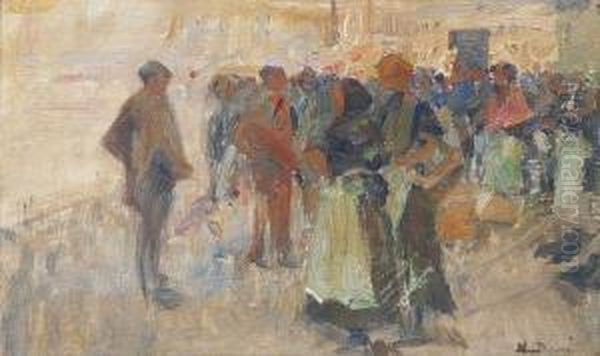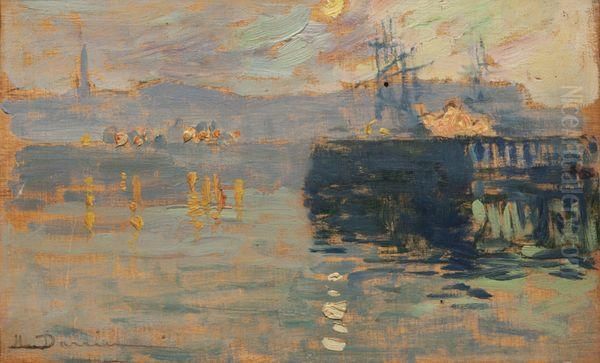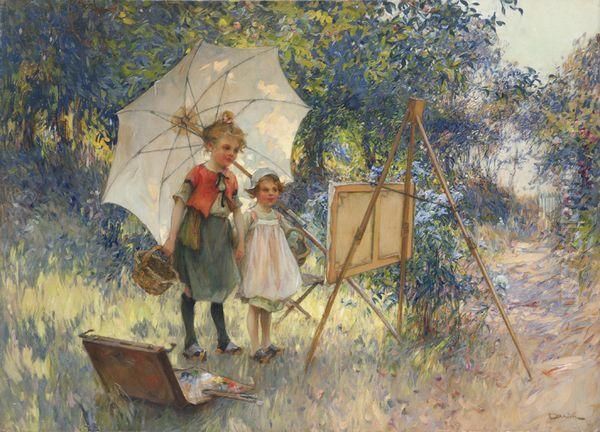
Henri Gaston Darien stands as a fascinating, if sometimes overlooked, figure in the vibrant tapestry of late 19th and early 20th-century French art. Born in Paris on January 8, 1864, and passing away in the same city on January 7, 1926, Darien's life and career spanned a period of immense artistic innovation and societal change. He was a dedicated painter, known primarily for his evocative landscapes, bustling Parisian scenes, and sensitive figure studies, navigating the complex art world that saw the entrenchment of Academic traditions, the revolutionary impact of Impressionism, and the diverse currents of Post-Impressionism.
Early Life and Artistic Inclinations
Details about Henri Gaston Darien's earliest years are somewhat modest, typical for many artists who did not achieve the stratospheric fame of some of their contemporaries. We know his father was a merchant, a background that might not immediately suggest a path into the arts, which often required either independent means or strong patronage. However, it appears that young Henri's artistic talents were recognized and, crucially, encouraged. By the age of sixteen, a pivotal moment in any young person's life, Darien had made the significant decision to dedicate himself to a career in art. This commitment, made around 1880, set him on a path of formal training and lifelong dedication to his craft.
Paris, his birthplace, was then unequivocally the art capital of the world. It was a city teeming with studios, academies, salons, and a palpable energy of artistic debate and creation. For an aspiring painter, there could be no better place to learn, to observe, and to begin forging an artistic identity. The decision to pursue art was not a light one, as the field was competitive, and financial stability was far from guaranteed. Yet, Darien embarked on this journey, ready to immerse himself in the rigorous training expected of artists at the time.
Formal Training: The Studios of Lefebvre and Guillemet
To become a professional artist in late 19th-century France typically meant undergoing rigorous academic training. Darien sought instruction from two notable masters of the period: Jules Joseph Lefebvre (1836-1911) and Antoine Guillemet (1841-1918). These choices of mentors are significant as they represent different, though sometimes overlapping, facets of the French art establishment.

Jules Lefebvre was a highly respected figure in the academic art world. A winner of the prestigious Prix de Rome in 1861, Lefebvre was renowned for his masterful figure painting and portraits, often of elegant women, executed with polished precision and idealized beauty. He was a prominent teacher at the Académie Julian, one of the most important private art schools in Paris, which attracted students from across France and internationally. Studying under Lefebvre would have provided Darien with a strong foundation in drawing, anatomy, and the classical principles of composition – skills highly valued by the official Salon. Artists like William-Adolphe Bouguereau and Jean-Léon Gérôme were titans of this academic style, emphasizing meticulous finish and often historical or mythological subjects.
Antoine Guillemet, on the other hand, offers a slightly different influence. While also a successful Salon painter, Guillemet was primarily a landscape artist. He was a friend to many of the Impressionists, including Édouard Manet, Camille Pissarro, Claude Monet, and Alfred Sisley. Guillemet himself, though, maintained a style that was more aligned with the Barbizon School's naturalism or a more structured form of landscape painting than the radical optical experiments of his Impressionist friends. He was known for his coastal scenes of Normandy and his views of Paris. Studying with Guillemet would have exposed Darien to the importance of landscape, the practice of plein air (outdoor) painting, and a sensitivity to light and atmosphere, albeit perhaps rendered with more traditional techniques than the Impressionists. Guillemet's own teacher had been Jean-Baptiste-Camille Corot, a pivotal figure bridging Neoclassicism and open-air landscape painting.
This dual tutelage equipped Darien with a versatile skill set: the discipline of academic figure drawing from Lefebvre and an appreciation for landscape and natural effects from Guillemet. This combination would prove foundational to his artistic development, allowing him to navigate different genres and themes throughout his career.
Salon Debut and Early Recognition
The Paris Salon, organized by the Académie des Beaux-Arts, was the most important art exhibition in the Western world for much of the 19th century. Acceptance into the Salon was crucial for an artist's reputation and commercial success. Henri Gaston Darien made his debut at this prestigious event in 1886. Significantly, at this time, he was still formally a student of Jules Lefebvre, indicating his precocious talent and the quality of his early work. To be accepted into the Salon while still under instruction was a notable achievement.

His participation in the Salon continued, and he began to garner official recognition for his efforts. In 1889, he received an honorable mention, a significant acknowledgment for a young artist. This was followed by a third-class medal in 1899 and a second-class medal in 1902. These awards, judged by a jury of established artists, signaled his growing stature within the art community. The medal system at the Salon was a clear hierarchy of achievement, and progressing through these ranks was a tangible measure of success.
Perhaps one of the pinnacles of his early career recognition came at the Exposition Universelle of 1900 in Paris. These world fairs were grand showcases of industrial, scientific, and artistic achievement. For an artist to be selected to exhibit, and then to win an award, was a major honor. Darien was awarded a gold medal at this event, placing him among the distinguished artists of his time and bringing his work to an international audience. This period, from his debut to the turn of the century, marked his firm establishment as a painter of note.
The Parisian Panorama: Capturing the Urban Scene
Henri Gaston Darien was, at heart, a Parisian. He spent his winters in the city, and its vibrant, ever-changing character provided him with a rich source of inspiration. His paintings often depicted the daily life of Paris, its streets, its quays, and its unique atmosphere. This focus aligns him with a tradition of artists who found their muse in the urban landscape, such as Jean Béraud, known for his detailed and lively portrayals of Parisian society on the boulevards and in its cafes, or Gustave Caillebotte, whose unique perspectives captured the modernity of Haussmann's Paris.
Darien's Parisian scenes were not just topographical records; they aimed to capture the animation of the city. He was interested in the flow of people, the play of light on wet streets, the hustle and bustle of commerce, and the more shadowy aspects of urban existence, sometimes being noted for depicting "crime scenes," although specific examples of these are less commonly reproduced. This interest in the narrative potential of the city, its human dramas unfolding against an urban backdrop, suggests an artist keen on observing and interpreting modern life.

His work likely reflected the Belle Époque (roughly 1871-1914), a period of optimism, peace, prosperity, and technological, scientific, and cultural innovations in France. Paris was at the center of this era, with its grand boulevards, new department stores, burgeoning café culture, and artistic ferment. Artists like Henri de Toulouse-Lautrec captured the nightlife of Montmartre, while Pierre-Auguste Renoir, in his earlier phases, depicted the joyful leisure of Parisians. Darien's contribution was his own distinct vision of this multifaceted city.
Normandy's Allure: A Contrast in Light and Landscape
Complementing his urban subjects, Darien had a deep connection to the countryside, specifically Normandy. He spent his summers at his home in Bénouville, a commune in the Calvados department, near Étretat, famous for its dramatic cliffs painted by artists like Gustave Courbet and Claude Monet. This seasonal rhythm – winters in Paris, summers in Normandy – provided him with a diverse range of subjects and environments.
In Normandy, Darien engaged extensively in plein air painting. This practice, popularized by the Barbizon School and central to Impressionism, involved painting outdoors to capture the fleeting effects of light and atmosphere directly. His Normandy landscapes would have contrasted sharply with his Parisian scenes, focusing on natural beauty, rural tranquility, and the specific qualities of Norman light, which had attracted artists for generations, from Eugène Boudin, a mentor to Monet, to Johan Barthold Jongkind.
His landscape work, likely influenced by Guillemet's teachings and the broader trends in French landscape painting, would have explored the fields, coastlines, and villages of the region. While perhaps not as radically experimental as Monet's series paintings of haystacks or Rouen Cathedral, Darien's landscapes would have demonstrated a keen observational skill and an ability to convey the essence of a place. The shift from the structured, man-made environment of Paris to the organic, natural forms of Normandy allowed him to explore different compositional challenges and color palettes.
Artistic Style: A Blend of Tradition and Modernity
Henri Gaston Darien's artistic style is best characterized as a blend of academic grounding with an openness to contemporary influences, particularly those related to capturing light and atmosphere. His training under Lefebvre would have instilled a respect for solid drawing and composition, while his association with Guillemet and his time spent painting en plein air would have pushed him towards a more naturalistic or even Impressionistic rendering of light and color, especially in his landscapes.
Initially, his focus was more purely on landscape. However, over time, his work evolved to increasingly incorporate figures within these landscapes, or to create scenes where figures played a more central role. This integration of figure and environment allowed for greater narrative and emotional depth. His Parisian scenes, by their very nature, were studies of figures within an urban setting.
His compositions were often described as "animated," suggesting a dynamic quality and an interest in capturing movement and life. This could be seen in the bustling activity of a quay or the subtle play of light at sunrise. While not an Impressionist in the strictest sense – he continued to exhibit at the official Salon, which often favored more conservative styles – his work likely absorbed some of the lessons of Impressionism regarding color theory and the depiction of light's ephemeral qualities. He probably occupied a space similar to other "juste milieu" painters who successfully blended academic technique with Impressionist sensibilities, appealing to both the Salon juries and a public increasingly accustomed to brighter palettes and looser brushwork. Artists like Henri Gervex or Alfred Stevens also navigated this territory.
Representative Works: Glimpses into Darien's World
While a comprehensive catalogue raisonné might be elusive for less globally renowned artists, several titles of Henri Gaston Darien's works give us an insight into his thematic concerns and artistic approach.
"Animation sur le quai" (Animation on the Quay) clearly points to his interest in the lively scenes of Parisian commerce and transport along the Seine. One can imagine a canvas filled with figures, carts, boats, and the architectural backdrop of the city, all rendered with attention to the specific light conditions and the sense of movement. Such scenes were popular, offering a snapshot of modern urban life.
"Soleil levant" (Sunrise) suggests a landscape or cityscape captured at a specific, evocative time of day. The theme of sunrise, famously tackled by Monet in his "Impression, Sunrise" (which gave Impressionism its name), was a challenge for artists wishing to capture delicate and rapidly changing light effects. Darien's version would likely showcase his skills in rendering atmospheric perspective and subtle color transitions.
"Enfants au jardin contemplant le tableau du père" (Children in the Garden Contemplating the Father's Painting) is a particularly intriguing title. It suggests a more intimate, perhaps personal, scene. This work could offer a glimpse into the artist's own life or a more generalized comment on art and family. The composition might involve a domestic garden setting, with the figures of children and the focal point of a painting within the painting – a meta-artistic statement. Such genre scenes, depicting everyday life with a touch of sentiment or narrative, were also popular during this period.
These titles, all oil paintings, indicate a painter engaged with the visible world, whether the man-made environment of Paris or the natural beauty of the countryside, and often with a focus on the human element within these settings.
Recognition and Later Career: The Legion of Honour
Darien's consistent output and the quality of his work continued to earn him respect within the French art establishment. In 1910, a significant milestone in his career was reached when he was made a Chevalier de la Légion d'honneur (Knight of the Legion of Honour). This is France's highest order of merit, both military and civil, and its bestowal upon an artist was a significant public acknowledgment of their contribution to French culture. This honor solidified his status as a respected and accomplished painter.
He continued to paint, dividing his time between his Parisian studio and his summer retreat in Bénouville. This pattern of life and work suggests a consistent dedication to his art, exploring the subjects that had long fascinated him. His later works would have continued to refine his style, perhaps reflecting the subtle shifts in artistic taste that occurred in the early 20th century, though he remained largely a representational artist.
The Final Years and Legacy
Henri Gaston Darien passed away on January 7, 1926, at the age of 62 (just shy of his 63rd birthday). Some sources indicate his death occurred at the Marmottan Museum in Paris. If accurate, this detail is poignant, suggesting he remained deeply connected to the art world until the very end. The Musée Marmottan Monet, as it's now known, is famous for its collection of works by Claude Monet, an artist whose dedication to capturing light and landscape resonated with Darien's own pursuits in Normandy.
While Henri Gaston Darien may not be as widely known today as some of his revolutionary contemporaries like Monet, Degas, or Post-Impressionists such as Van Gogh or Cézanne, his career is a testament to the enduring appeal of skilled representational painting that also engaged with modern life and the beauty of the French landscape. He successfully navigated the official Salon system, earning accolades and respect, while also absorbing some of the atmospheric and luminist concerns that characterized the art of his time.
His work provides valuable insight into the artistic currents of the Belle Époque, showcasing a painter who could skillfully render the bustling energy of Paris and the serene light of the Normandy countryside. He represents a significant group of artists who, while perhaps not at the cutting edge of the avant-garde, produced work of high quality that was appreciated in its time and continues to hold interest for its depiction of a bygone era and its inherent artistic merit. His dedication to his craft, from his early studies with Lefebvre and Guillemet to his consistent output and official recognition, paints a picture of a serious and accomplished artist who contributed to the rich artistic heritage of France. His paintings serve as visual documents of his time, filtered through a sensitive artistic temperament, offering viewers a window into the world he inhabited and observed with such dedication.